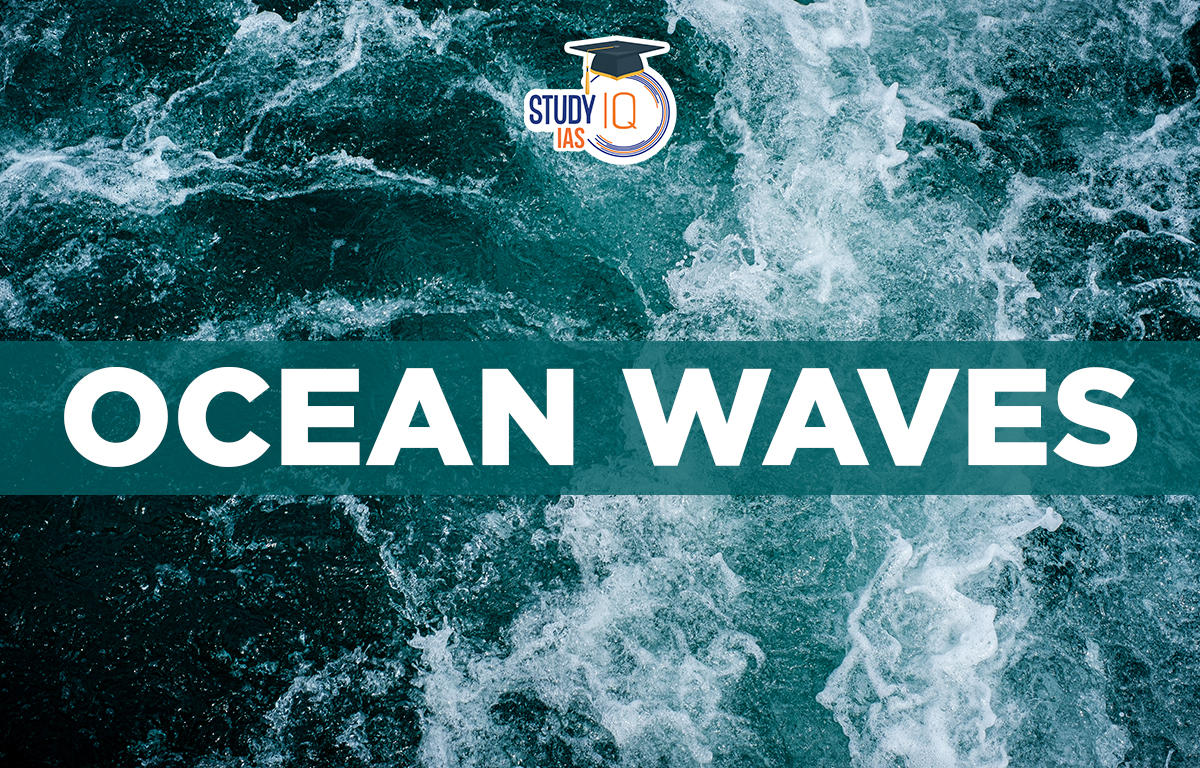Table of Contents
Ocean Waves
Ocean Waves: An Ocean wave is a ridge or a swell on the surface of a body of water. They are oscillatory surface water movements resulting in the rise and fall of surface water. Waves are the horizontal movements of ocean water. They are the energy that moves across the ocean surface, not the water itself. The wind provides this energy for the waves. Each water particle in a wave moves in a circular motion. The raised portion of a wave is known as the crest, while the low point is known as the trough.
Ocean Waves Diagram
Here is an illustration of an Ocean Waves

Ocean Waves Energy
Sea waves appear that water is migrating in the direction of wave travel, but only a slight amount of water is advancing. It is the wave energy moving through the flexible medium of water. Water simply transfers energy from molecule to molecule in simple cyclic rotations.
These are oscillatory waves in which an individual particle, such as a drop of water or a small floating object, completes one vertical circle or wave orbit with the passage of each wavelength.
When waves advance in the open waters, particles trace an orbit in which the forward speed of each particle at the crest is slightly greater than the backward speed at the trough. As a result, the net forward motion of water is associated with most ocean wave trains. The amount of motion depends on the size and steepness of the waves. Strong waves are capable of pushing large amounts of water toward the beach.
Ocean Waves Formation
Waves are created when energy passes through water and cause it to move in a circular motion. As a wave passes, water particles only move in a small circle. The waves are powered by the wind. Wind causes waves to travel in the ocean, releasing energy along coastlines.
Ocean Waves Origin and Movement
The size and shape of a wave reflect its origin. Steep waves are relatively new and are most likely created by local wind. Waves that are slow and steady are coming from far away, possibly from another hemisphere. The maximum wave height is governed by the wind’s intensity, which is influenced by how long it blows and the region it blows over in a single direction.
As a result, wind speed, duration, and fetch all influence the height of waves (the distance that the wind blows over the water). With increasing wind speed, the height of the waves rises quickly. The square of the height of a wave determines its energy. As a result, hurricane winds can produce enormously destructive waves.
Ocean Waves Propagation
The waves propagate forward because the wind drives the water body in its direction, while gravity drags the crests of the waves downward. As the receding water pushes the earlier troughs upward, the wave advances to a new spot. The water beneath the waves moves in a circular manner. As the wave advances, everything is dragged up and forward, then down and back as it passes.
The following are a few important terms relating to waves:
- The highest and lowest points of a wave are called the crest and trough, respectively.
- Wave height is the vertical distance between the trough and crest.
- Wave amplitude is one-half of the wave height.
- Wavelength is the horizontal distance from trough to trough or from crest to crest.
- The wave typically travels forward as parallel fronts of crests and troughs.
- The wave period is the time in seconds between successive crests or successive troughs that pass a fixed point.
Ocean Wave Break
Breaking of a wave complex phenomenon in which the surface of the wave folds or rolls over and intersects itself. In the process, it may mix (entrain) air into the water and generate turbulence. Swells are regular patterns of smooth, rounded, and mature undulations in the open ocean. The friction between the moving water and the seafloor causes waves to slow down as they approach shallow water. The wave is slowed and steepened by the drag of the seashore.
The wave breaks when the depth of the water is less than half the wavelength of the wave. On the other hand, the wave top continues its forward momentum and eventually falls down into the wave’s face, forming a breaker. The water surges forward, foamy and furious, and rides up the beach slope. This violent swash causes sand and gravel on the beach to flow landward.
After the swash’s energy has been dissipated against the beach’s slope, the backwash, or return flow, pours down the beach. Bathers can be swept off their feet and carried seaward beneath the next impending surf by this “undercurrent” or “undertow.” The backwash transports the sand and gravel back to the sea, bringing the wave cycle to an end.
Most of the waves that impact the coastal zone originate in one of three ways:
- Tidal waves are very long wavelength waves caused by the interactions between the Earth, the moon, and the sun.
- Tsunamis waves result from sudden water displacement due to the tectonic movement along faults, landslides, volcanic eruptions, or other impulsive events.
- Most of the waves that impact the coastal zone are wind waves, created when air currents push along the water’s surface.
Ocean Waves UPSC
The ocean never remains still. There are various types of ocean water movement caused by physical characteristics such as temperature, salinity, density, and so on. External forces such as the sun, moon, and winds also influence ocean water movement. A solid understanding of this subject is required to help individuals pass competitive exams. On that note, we have covered this topic exclusively for students preparing for the UPSC and IAS exams.





















 WhatsApp
WhatsApp